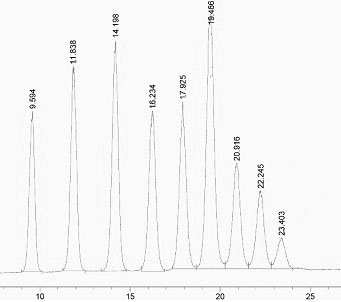Carbomenu provide high-purity Maltooligosaccharides
Maltooligosaccharides are usually composed of 2 to 10 α- D -gluco-pyranosyl units linked solely by α-1,4 glycosidic linkages.Carbomenu improves the high purity maltooligosaccharide,Maltooligosaccharides can be produced on an industrial scale. 1kg, 10kg or 25kg is optional.
Maltotriose 1kg ~ 100kg
Maltotetraose 1kg ~ 100kg
Maltopentaose 100g ~ 25kg
Maltohexaose 100g ~ 25kg
Maltoheptaose 100g~ 1kg
Maltooctaose 100g ~ 1kg
High-performance liquid chromatography (HPLC) has been used to purification the product components. Malto-oligosaccharides can be purified ,HPLC>90% or HPLC>98% .
HPLC analysis is carried out on HILIC Amide COLUMN, using water or a mixture of acetonitrile and water as the mobile phase. The products are usually detected by using a refractive index detector or by using an evaporative light scattering detector as a sensitive and accurate substitute.
Our Column for maltooligosaccharides Analysis:
HILIC Amide COLUMN 4.6mmx250mmI.D.,

This method uses ultra-performance liquid chromatography separation coupled with an evaporative light scattering detector.
Maltooligosaccharides are usually composed of 2 to 10 α- D -gluco-pyranosyl units linked solely by α-1,4 glycosidic linkages. MFAses are essential enzymes for the production of maltooligosaccharides. Thus, the potential value of MFAses has resulted in a significant amount of effort being devoted to the discovery, preparation and characterization of related amylases.The industrial production of maltooligosaccharides follows a process composed of three main steps: starch liquefaction,saccharification, and purification.
As one of the most common glycosyl hydrolases, α-amylase (1,4-α- D -glucan glucanohydrolase; EC 3.2.1.1) randomly cleaves the α-1,4 glycosidic linkages of starch to yield maltodextrin, maltooligosaccharides, or glucose.During the past few decades, MFAses expressed by bacteria, especially Bacillus sp., have been extensively studied, while some mesophilic and thermophilic fungi have also been reported to produce MFAses. The microbial strains that have been recognized as sources of MFAses . In several instances, these amylases have excellent product selectivity.



